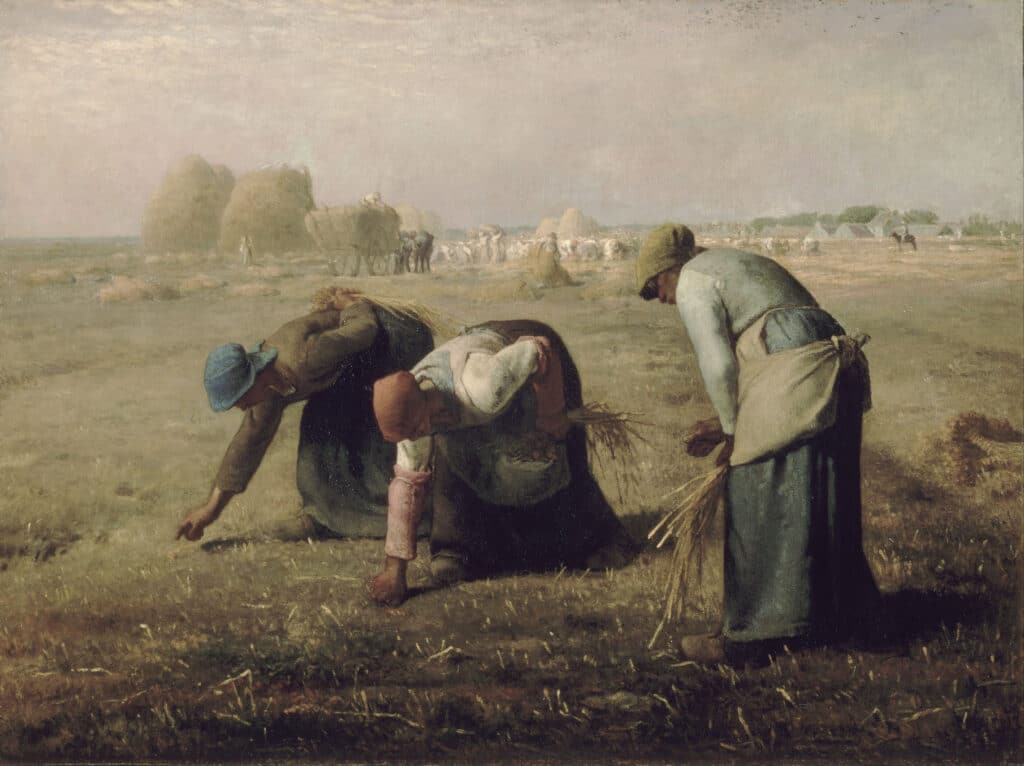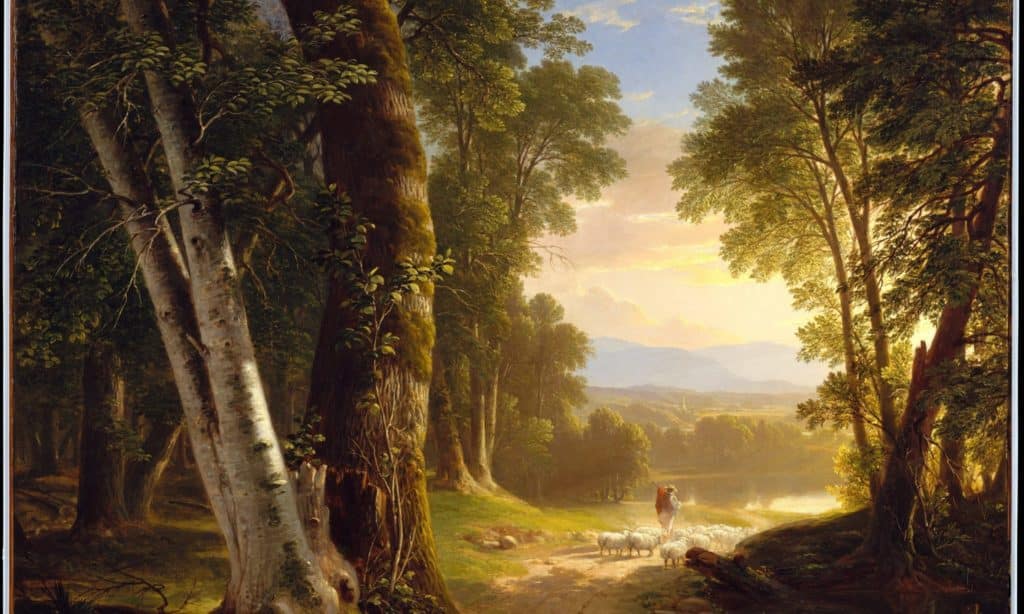
What Is the Canon Like?
This is an Altum essay.
When we speak of the canon or of classic texts in a world that has come to question whether or not such a thing exists, it is important that we find proper metaphors to describe this organic process whose life cycle we can’t observe fully in our own generation. When I hear people talk about it—those who still believe it is a worthy conversation—they seem tempted to think of it as a machine that either stays the way it has always been built or gets mechanically added to like a second-generation robot to correct oversights and absences. But the canon grows like a garden with heirloom seeds not GMOs, and the gardener is the reading world over many years. Or you could say that each book that is made is a seed, and we understand its lifecycle by its fruitfulness. This requires it to grow other plants, to produce ‘fruit’, and to continue to nourish and delight others. Here are some principles in the search for a good likeness of what it is.
The metaphors we choose for the canon are far more than decorative. If this conversation has tacitly adopted an inorganic vision for an organic process, as so many other conversations in our time have, we might need to collectively refine them and examine the underlying assumptions of the ones we are currently using. Andrew Louth says “metaphors are not simply embellishments of what could equally easily be stated in plain literal prose. Metaphors, rather, disclose a way of looking at the world, a way of understanding the world” (Louth 19).
Our metaphors must reflect the fact that if readers don’t keep reading books from the tradition, and writing more books in cooperation with it, the canon, doesn’t continue. Louth gets at this when he emphasizes the freedom of tradition.
Language and literature disclose to us the moral realm of free human agents… In it we are confronted with the mystery of human freedom as opposed to the puzzle of the interaction of natural laws; and this is a mystery in which we participate. The world of history depends on freedom and this remains an ultimately unplumbable mystery of the human person… The discovery of the true meaning of a text or of a work of art is never finished—there is no ‘original meaning’—it is rather an infinite process whereby tradition is handed on (33-34).
Louth is talking about the individual or community of readers in relation to the interpretation of a single book but clearly this applies to the tradition or the classics as a whole—it is like a living garden, and it depends on us gardeners and not only on some nominal selection criterion someone used once or imposes now. It is a thing that grows by human freedom and cultivation. Hans George Gadamer also helps us to keep our methods human-scaled and conservation oriented and not laboratory-made.
Nothing is so purely the trace of mind as writing, but also nothing is so dependent on the understanding mind. In its deciphering and interpretation, a miracle takes place: the transformation of something strange and dead into a total simultaneity and familiarity. This is like nothing else that has come down to us from the past… A written tradition, when deciphered and read, is to such an extent pure mind that it speaks to us as if in the present. That is why the capacity to read, to understand what is written is like a secret art, even a magic that looses and binds us. In it time and space seem to be suspended. The (hu)man who is able to read what has been handed down in writing testifies to and achieves the sheer presence of the past. (Louth 34)
The canon is safeguarded by this mystery of reading, of minds coming to similar conclusions separately again and again over vast swathes of time. The canon is a human creation that must be planted, sustained, loved, tended, weeded to continue. We must manure it year after year and dig up the fig plants that might get killed in the winter. The clockwork or machine-like CANON is a fiction. The canon that you can simply add to in order correct the bias of the past is also a fiction. See the criterion here from Italo Calvino (a cane or measuring stick from the root of the word canon).
One part of the ongoing life of the classics is the work they have done in lives of the oppressed. In many cases, this has generated texts that will themselves find their way under the umbrella of classic. Frederick Douglass’ autobiography seems to be an example like this. He was nourished on these books and wrote his own to tell part of the story that, especially to us Americans, is essential. But here still we will see how those generations that follow us in our country and abroad decide on this matter. If you have a book that you think ought to be read by others, by all means introduce it, promote it, put it in your syllabus, write about it, make it breathe with the life you have discovered. Then wait about 100 years to see how others receive your offer—that is how this thing works. There isn’t some external set of criteria that we can indiscriminately apply as a committee to make our fail-safe list. Time and real bodies of people, that never gather in a room, make this judgment. The heirloom seeds keep making vegetables and flowers, the GMOs don’t.
I appreciate Angel Parham’s awareness that the canon or the classics have all sorts of commentators, observers, and lovers and their wide variety of voices ought to be lifted up. We will see if they become part of the garden in time, or if those they lift are part of the garden because they become beloved, necessary, life-generating for others.
Instead of reducing the presence of canonical works in our curricula or eclectically mixing in diverse writers, we build on the classical core by bringing diverse voices and stories to the fore. These were already present in the tradition, but they haven’t been adequately heard. Many later great writers, including people of color, were inspired by and built on the classics. (“Don’t Cancel the Classics” WSJ)
Tolkien started the process of re-introducing Beowulf, as it had fallen out of reading. He uplifted it by writing about it (“The Monsters and the Critics”) by borrowing from it (The Lord of the Rings and the Hobbit), by giving lectures on dragons at the Ashmolean Museum in Oxford to ten-year-old’s, and by assigning it in his classes, he also quoted it in Anglo-Saxon from memory and probably took students (or at least his kids) to the British Museum to see artifacts from its period. Over time all of us and others in the last almost 100 years have received and planted it in our lives. Recently, I badly wanted to go see Benjamin Bagby performing it in song with his harp. Tolkien could not singlehandedly make Beowulf a classic text that was assured a place in every classroom. Bagby and Tolkien work together across years and miles and from different centuries. There is not a yardstick, a ruler, a measure (again, take note of the root words for canon) that will do this without the living human beings in communities over long time series cutting the measuring cane over and over.
The canonical books of scripture are different, they have authority attached to their selection despite the complexity of that task. It is tempting to see this as an analogy for what has happened in the non-conciliar world of literature—in the case of scripture, authoritative bodies got together and labored and sifted and used their collective minds to arrive at consensus that we consider the mind of the church. Because the process for the books of scripture is not simple and linear with one date on the calendar, it is tempting to think of that process as an analogy to what has happened in non-biblical literature. This would be and has been an error. Here an article that does a good job of showing you the various parts of that collection process:
Don’t import the process of the canonization of scripture to that of our broader literary inheritance. As much as we contribute to defining a body of literature as individuals, schools, epoch’s, we don’t decide this once and for all, instead only time and love ensure it.
I, along with the Pulitzer committee, have raised the voice of Marilynn Robinson. I recently wrote an article that describes her dialogue with Homer in her Gilead books (now a tetralogy). If my grandchildren’s grandchildren are reading her books, they may be able to call her work classic. I’m giving it a great shot by teaching her, writing about her, perhaps writing a book that takes hers as a model and makes that homage visible. I cannot put Robinson in the canon or call her classic, that is act of hubris but also of unreality. She would not be happy or relieved if I did this—she will trust only the voices and curriculum of my grandchildren’s grandchildren. Obviously, she will be dead or fully alive in Christ then, and this is precisely the point I am trying to convey in this writing. We do not mechanically choose who will be read or stop being read or added to, and we can’t see the outcomes in our lifetime. Here are some others I’d like to add: Tyehimba Jess, Osip Mandelstam, and Anna Akhmatova (to name only a few). But thank God, I alone am not sufficient to the task. Let’s share the traces of mind that have animated ours and the minds that animated them and use better metaphors that offer a clearer understanding. It is easy to respond to the totalitarian cultural voices with a totalitarian response of our own on either end of a spectrum.
We will need more analogies to work on getting this right. Dr. Timothy Patitsas observes in his book The Ethics of Beauty “the point is not to create artificial Forms that have no depth and no staying power” (462). Indeed, the notion of the canon easily becomes a form that is artificial, that stands for tradition. He elaborates using the notion of the blueprint.
A Pattern, an archetype, is something living; it trembles, it sways with the passage of time. A blueprint, by contrast, is something fixed; it is suitable if you would guide the creation of a machine but not for the generation of a living organism. The artist is trying to give birth to a living being and so requires a living seed not a dead one. (463)
Here, over a hundred pages, he describes the city planner Jane Jacobs who objected to blueprints for city reform that didn’t take into account people’s actual patterns and use. The building of a machine and the blueprint mentality versus something living be that a seed, a garden, a de facto walkway on a college campus, or a city neighborhood are helpful for the contrast I’m trying to draw. The canon is the books that keep being read because people love them, assign them, speak of them, write using them, and are in deep fellowship with their authors. Some prefer the language of ‘the great conversation’ that has continued murmuring over centuries. Some use language of ‘the great questions’ that keep bubbling up (see the Templeton Honors College at Eastern University).
Solzhenitsyn, prophet of the Russian gulag, creates his index this way in his Nobel Laureate acceptance speech. He says that art and literature have an effect on us:
…to overcome man’s ruinous habit of learning only from his own experience, so that the experience of others passes him by without profit. Making up for man’s scant time on earth, art transmits between men the entire accumulated load of another being’s life experience, with all its hardships, colors, and juices. It recreates—lifelike—the experience of other men so that we can assimilate it as our own. (519)
Literature that conveys the load of another’s life experience is getting into the texture and timbre of why the classics become indispensable but also how incapable we are of treating them like a leaden castle that never changes or a wax sculpture that is easily subtracted from or added to. In fact, Christopher Alexander insists that there is a quality that has no name that all living and lasting patterns have. Here he is speaking of buildings because he is an architect.
We have been taught that there is no objective difference between good buildings and bad, good towns and bad. The fact is that the difference between a good building and a bad building, between a good town and a bad town, is an objective matter. It is the difference between health and sickness, wholeness and dividedness, self-maintenance and self-destruction. In a world which is healthy, whole, alive, and self-maintaining, people themselves can be alive and self-creating. In a world which is unwhole and self-destroying, people cannot be alive: they will inevitably themselves be self-destroying and miserable. But it is easy to understand why people believe so firmly that there is no single, sold basis for the difference between good building and bad. It happens because the single central quality which makes the difference cannot be named. (A Timeless Way of Building 25)
Notice that he calls it an objective matter but says it has a quality which cannot be named and must be experienced by many over time. These many who experience it will find it to be life giving, health-giving. I’d like to add it to my analogy catalogue for the canon: it is like a building that lives that we keep feeling comfortable inside of and using well and properly and loving and maintaining because of the ways it serves us (serves in all ways including in its beauty). It is ‘self-maintaining’ and ‘almost imperishable’ because it has that quality, but naturally it is loved and preserved by those who have recognized it either intuitively or formally. There is a paradox here because these gardens use seeds that keep being fruitful, or buildings have shape and materials that live on and on but still need us to love, plant, save, and maintain them.
As the title of Parham’s article suggests, she describes various ways that we can broaden instead of canceling the classics.
My organization’s curriculum pairs Homer’s “Odyssey” with African American artist Romare Bearden’s paintings that reinterpret the tale as an allegory for the trans-Atlantic African diaspora. To understand novelist Toni Morrison (herself a classics minor at Howard University), one must read her work alongside her influences: Ovid and Euripides. (“Don’t Cancel the Classics...” WSJ)
While we don’t know if Morrison or Bearden will take on the lasting life of Ovid. We can honor the classics by showing what they have generated. In this way we elevate more voices but at the same time we lift up the classic and show the gratuity and abundance of the life they contain. Let’s see what happens with the planted seeds as time passes and continue to teach well those in close dialogue with classic texts. We want more voices, more lasting texts that achieve the carrying of experience that Solzhenitsyn names, let’s lift them up understanding that they will have to do their own work, adding their own appeal directly to human hearts not yet born.
Works Referenced:
- Andrew Louth Discerning the Mystery
- Christopher Alexander A Timeless Way of Building
- Italo Calvino Why Read the Classics
- Angel Parham “Don’t Cancel the Classics” in the Wall Street Journal
Note: Guest bloggers share their own thoughts as classical educators and learners and do not represent ClassicalU.com or Classical Academic Press. If you are interested in writing guest blog content, please contact us with your name, connection to classical education, and ideas for a blog post.
Christine Perrin has taught literature and writing at Johns Hopkins University, Gordon College’s Orvieto Program, the Nashotah House Seminary, through the Pennsylvania Arts Council to students of all ages, and at Covenant Christian Academy where her husband was headmaster for a decade and where her children attended K–12. (Learn more here as well as with her course The Art of Poetry on ClassicalU.)








Responses